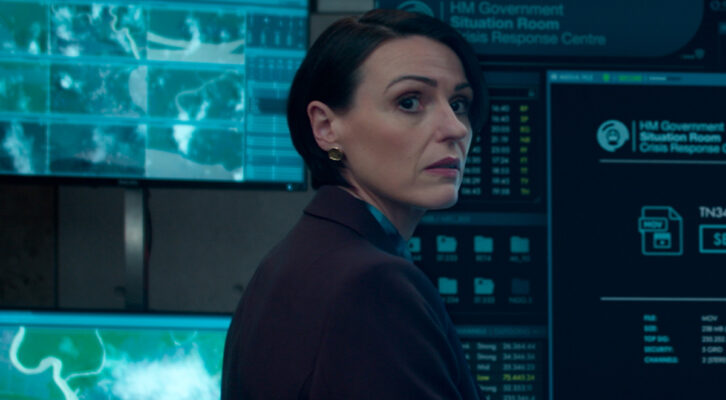Hollywood doesn’t have the greatest track record when it comes to accurately portraying cyberattacks onscreen. Many movies feature a character—often a stereotypically nerdy hacker with thick eyeglasses—smacking a keyboard like an angry chimp until they’re granted access to a highly secure system. For good measure, the hacker might yell random tech phrases like “firewall!” or “NSA!” as they pound away.
It’s easy to see why this trope developed. Real-life hacking is a meticulous, quiet process. It can take months for a dedicated team of cyber-attackers to penetrate a target system, and there’s often precious little sign of their presence—a database copied here, a file deleted there. It’s not very cinematic, which is why directors and writers have fallen back on the keyboard-pounding, the screaming, the flashy graphics.
A decade ago, the director Michael Mann, famous for sleek crime epics like “Heat” and “Collateral,” tried to make a thriller that portrayed hacking in a more accurate (and frightening) way. The result was “Blackhat,” which by all indications should have been a hit: it starred Chris Hemsworth, famous for playing the superhero Thor in the Marvel comic-book movies, and featured the flashy shootouts and pyrotechnics that usually puts people in theater seats.
Instead, “Blackhat” failed at the box office, and you’d be hard-pressed to find anyone who’d put it at the top of their list of favorite Michael Mann flicks—including, perhaps, Mann himself. “The script was not ready to shoot,” he told Variety in 2023. “The subject may have been ahead of the curve, because there were a number of people who thought this was all fantasy. Wrong. Everything is stone-cold accurate.”
But “Blackhat” is worth a second watch, or maybe even a third. Here’s why:
The Hacking is Somewhat Realistic
As Mann alluded in that Variety quote, a ton of research went into “Blackhat,” and it shows. The hacks themselves are oversized—the movie opens with an attacker remotely causing a nuclear reactor to melt down, continues with a code-based infiltration of the stock market, and features a vast fortune being stolen—but also plausible, at least in theory. Hemsworth’s protagonist, Hathaway, picks through open-source code, critiques a cyber-attacker’s scripting abilities, and executes a few straightforward hacks onscreen.
Cybersecurity has evolved quite a bit since the movie came out—the rise of A.I. has made the job of attacking and defending IT infrastructure infinitely more complex, for starters—but Hemsworth deploys real techniques, not screenwriter gobbledygook (“firewall!” pounding keys “hacking encryption!”).
Mann clearly puzzled over how to make the hacks themselves more cinematic, and came up with the idea of having the camera zoom through the innards of a server or laptop as malicious code is activated. At this microscopic level, code executions are portrayed as tsunamis of light washing over hardware. It’s more representational than literal, sure, but the results have aged a lot better than the computer-based shenanigans of the hacking movies of the ‘90s and ‘00s, which are a) generally corny, and b) have zero resemblance to any known computing reality.
The Crime Plot is Pretty Good, Too
Despite its title, actual hacking takes up a relatively small amount of the movie’s overall running time. At its core, “Blackhat” is a globe-trotting crime caper, a cops-and-robbers drama on an epic scale. The shootouts don’t quite measure up to the legendary status of the bank robbery sequence in Mann’s “Heat” (1995), but they’re sublimely paced and well-orchestrated (except for one brief gunfight that’s largely there to take most of the characters off the game board). And the final sequence, which takes place amidst a crowd of torch-bearing festival-goers, is perhaps the apogee of Mann’s decades-long experiments with shooting on digital video—artistic and kinetic in equal measure.
It Fits Well with Mann’s Overall Filmography
Mann’s first big crime movie, “Thief” (1981) featured James Caan as a high-end burglar who employs sophisticated means to take down highly secured vaults; in this context, ‘sophisticated’ means thermal lances and other industrial-age tools. Almost thirty years later, Mann directed “Public Enemies” (2009), in which Johnny Depp as John Dillinger used a tommy gun to knock off banks in the 1930s Midwest.
Then you have “Heat 2,” the novel that Mann wrote with Meg Gardiner in 2022, and which serves as both a prequel and a sequel to “Heat” (it may also become a movie, if everything continues to line up with casting and budget). Part of that book follows Chris Shiherlis (played by Val Kilmer in the original film) as he escapes the events of the original film, then sets himself up as an up-and-coming crime lord in Ciudad del Este on the Triple Frontier. As the plot ticks from the ‘90s to the turn of the century, Chris is at the forefront of crime’s evolution; it’s no longer about punching through safe locks with tools or threatening bank managers with guns, but hiring mercenaries online, leveraging the global supply network, and paying attention to counterintelligence.
“Blackhat” fits neatly into Mann’s overarching thesis that, when it comes to crime, iron and steel are giving way to silicon. Sure, its characters still shoot and stab each other, but the biggest weapons are the keyboards and the command lines used to steal millions, destroy infrastructure, and put whole countries at risk. In the 11 years since the movie was released, we’ve seen massive hacks that’ve resulted in everything from supply-chain disruptions to millions of Americans’ personal data siphoned to the dark web. Mann predicted our dark future; it’s too bad too few people saw it at the time.














